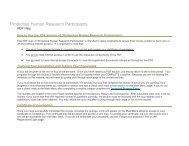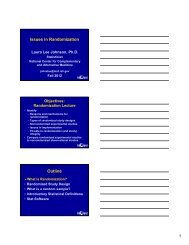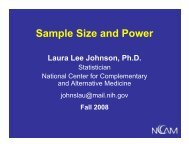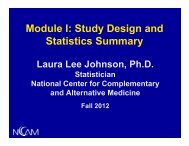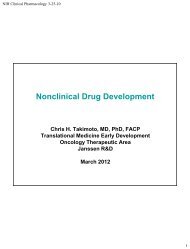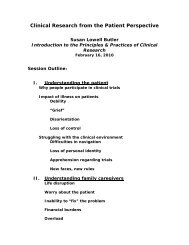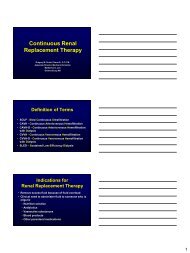Design of Case Report Forms
Design of Case Report Forms
Design of Case Report Forms
You also want an ePaper? Increase the reach of your titles
YUMPU automatically turns print PDFs into web optimized ePapers that Google loves.
<strong>Design</strong> <strong>of</strong> <strong>Case</strong> <strong>Report</strong><br />
<strong>Forms</strong><br />
David W. Mailhot<br />
February 23, 2010<br />
<strong>Case</strong> <strong>Report</strong> Form<br />
• ..CRF<br />
Official clinical data-recording document or<br />
tool used in a clinical study<br />
PAPER<br />
RDC/RDE (Remote Data Capture,<br />
Remote Data Entry)<br />
Purpose<br />
Collects relevant data in a specific format<br />
• in accordance with the protocol<br />
• compliance with regulatory requirements<br />
Allows for efficient and complete data<br />
processing, analysis and reporting<br />
Facilitates the exchange <strong>of</strong> data across<br />
projects and organizations especially through<br />
standardization
CRF Relationship to<br />
Protocol<br />
Protocol determines what data should be<br />
collected on the CRF<br />
All data must be collected on the CRF if<br />
specified in the protocol<br />
Data that will not be analyzed should not<br />
appear on the CRF<br />
Protocol<br />
Analysis<br />
Plan<br />
Describes Study Conduct<br />
•purpose<br />
•objectives<br />
•operational aspects<br />
Describes Analysis<br />
•data presentations<br />
•key endpoints<br />
•statistical methods<br />
<strong>Case</strong><br />
<strong>Report</strong><br />
Form<br />
Collects data to support<br />
the above<br />
CRF Development<br />
• Guidelines<br />
Collect data outlined in the protocol<br />
Collect data to support the analysis plan<br />
Collect data required by the regulatory<br />
agencies
CRF Development<br />
• Guidelines (con’t)<br />
Collect data with all users in mind<br />
Be clear and concise with your data questions<br />
Avoid duplication<br />
Request minimal free text responses<br />
Provide units to ensure comparable values<br />
Provide instructions to reduce<br />
misinterpretations<br />
CRF Development<br />
• Guidelines (con’t)<br />
Provide “choices” for questions where possible<br />
Use <strong>of</strong> “None” and “Not done” for assesments<br />
Collect data in a fashion that allows for the<br />
most efficient computerization<br />
Collect data and formats that provides for<br />
pooling across studies<br />
CRF book needs to be finalized and available<br />
before an investigator starts enrolling patients<br />
into a study<br />
Elements <strong>of</strong> the CRF<br />
• Three major parts:<br />
Header<br />
Safety related modules<br />
Efficacy related modules<br />
• Module block <strong>of</strong> specific questions<br />
• CRF module(s) make up a single CRF page<br />
• CRF Book series <strong>of</strong> CRF pages
Header Information<br />
• Key identifying Information<br />
• MUST HAVES<br />
Study Number<br />
Site/Center Number<br />
Subject identification number<br />
Creating Safety Modules<br />
• Ideally come from a standard library<br />
• Select modules appropriate for your study<br />
• Keep safety analysis requirements in mind<br />
• Safety Modules usually include<br />
• Demographic<br />
• Adverse Events<br />
• Vital Signs<br />
• Medical History/Physical Exam<br />
• Concomitant Medications<br />
• Patient Disposition/Status at end <strong>of</strong> study<br />
Efficacy Modules<br />
• <strong>Design</strong>ed for each therapeutic area based on the<br />
protocol<br />
• Primary and secondary efficacy<br />
endpoints/parameters<br />
• Health Outcomes Assessments/Questionnaires<br />
• Considered to be “unique” modules and can be<br />
more difficult to develop<br />
• Use existing examples from similar protocols<br />
where applicable
Creating Efficacy Modules<br />
• Follow general CRF design guidelines<br />
• Include appropriate baseline measurements<br />
• Repeat same battery <strong>of</strong> tests<br />
• Define and identify<br />
• key efficacy endpoints<br />
• diagnostic tests for efficacy<br />
Importance <strong>of</strong> Standard<br />
CRFs<br />
• Prepares the way for data exchange<br />
• Removes the need for mapping during data<br />
exchange<br />
• Allows for consistent reporting across protocols,<br />
across projects<br />
• Promotes monitoring and investigator staff<br />
efficiency<br />
• Allows merging <strong>of</strong> data between studies<br />
• Provides increased efficiency in processing and<br />
analysis <strong>of</strong> clinical data<br />
CRF Development<br />
Process<br />
•Drafts CRF from protocol<br />
CRF <strong>Design</strong>er<br />
• CRF Review Meeting<br />
• Comments back to designer<br />
Reviewers<br />
CRF <strong>Design</strong>er<br />
• Updates CRF to include comments<br />
• Review and Sign <strong>of</strong>f/approval<br />
CRF Book<br />
• Coordinate printing and distribution<br />
Site
CRF Development Process<br />
• Responsibility for CRF design can vary between<br />
clinical research organizations (CRA, data<br />
manager, specialty role)<br />
• Interdisciplinary review is necessary<br />
• Each organization has its own process for<br />
review/sign-<strong>of</strong>f<br />
• Should include relevant members <strong>of</strong> the<br />
project team involved in conduct, analysis<br />
and reporting <strong>of</strong> the trial<br />
• Begins<br />
• As soon as possible in the study planning<br />
process (draft protocol)<br />
CRF Development Process<br />
• Review Team (example)<br />
• Clinician<br />
• CRA<br />
• Statistician<br />
• Programmer<br />
• Data Manager<br />
• Others<br />
• Database Development, Dictionary Coding,<br />
Standards<br />
CRF Development Process<br />
• After the CRF book is approved<br />
Initiate the process for printing<br />
Note: the Protocol must be approved before the<br />
CRF book is approved and printed<br />
• After it is printed<br />
Stored according to organizational guidelines<br />
Printed and distributed to research sites
Properly <strong>Design</strong>ed CRF<br />
• Components/All <strong>of</strong> the CRF pages are<br />
reusable in future studies<br />
• Saves time<br />
• Saves money<br />
+<br />
Poorly <strong>Design</strong>ed CRF<br />
• Necessary data not collected<br />
• Database may require modification<br />
• Data Entry process impeded<br />
• Need to review/clean data increases<br />
• Target dates are missed<br />
• Collected too much data – Wasted resources in<br />
collection and processing<br />
• Delay in getting study results and ability to<br />
adequately test the protocol objectives<br />
The <strong>Case</strong> <strong>Report</strong> Form<br />
• How do we use it?<br />
• Collect data from the investigational sites<br />
• Helps project team and study site team<br />
• Reminder to investigator to perform<br />
specific evaluations<br />
• CRA uses to verify protocol is being<br />
followed and compare with source<br />
documents<br />
• Statistics and Programming groups use it<br />
to build database structures, develop edit<br />
checks and programming specs
The <strong>Case</strong> <strong>Report</strong> Form<br />
• ...Data is Used for<br />
• Data analysis and reporting<br />
• Subject tracking<br />
• <strong>Report</strong>s to FDA on subject safety<br />
• Promotional materials<br />
• New Drug Application submissions<br />
• Support <strong>of</strong> labeling claims<br />
• Publication in medical journals<br />
Electronic CRFs<br />
• The use <strong>of</strong> RDC is increasing<br />
• In general, the concepts for the design <strong>of</strong><br />
electronic CRFs/RDC screens are the same as for<br />
paper CRFs<br />
• Electronic CRFs will impact the following:<br />
Review <strong>of</strong> CRF is different (screen review)<br />
No need to print and distribute paper<br />
Responsibility for Data entry<br />
Data quality checks at source<br />
Electronic CRFs and Data Capture<br />
• Types <strong>of</strong> Systems<br />
Direct entry into active database<br />
Entry into local disc/holding file for later<br />
loading/transfer<br />
Entry with second review necessary in<br />
order to change “status”
CRF Completion Guidelines<br />
• Used to give both general and specific guidance to<br />
facilitate quality data collection<br />
• Partial Dates<br />
• Unknowns<br />
• Missed Visits<br />
• Unplanned visits<br />
• Discontinued Subjects<br />
• May also include navigation or technical<br />
instructions associated with an EDC system<br />
Examples
Questions ?



